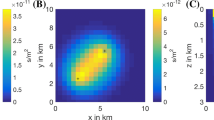Abstract
Recently, coda-wave interferometry has been used to monitor temporal changes in subsurface structures. Seismic velocity changes have been detected by coda-wave interferometry in association with large earthquakes and volcanic eruptions. To constrain the spatial extent of the velocity changes, spatial homogeneity is often assumed. However, it is important to locate the region of the velocity changes correctly to understand physical mechanisms causing them. In this paper, we are concerned with the sensitivity kernels relating travel times of coda waves to velocity changes. In previous studies, sensitivity kernels have been formulated for two-dimensional single scattering and multiple scattering, three-dimensional multiple scattering, and diffusion. In this paper, we formulate and derive analytical expressions of the sensitivity kernels for three-dimensional single-scattering case. These sensitivity kernels show two peaks at both source and receiver locations, which is similar to the previous studies using different scattering models. The two peaks are more pronounced for later lapse time. We validate our formulation by comparing it with finite-difference simulations of acoustic wave propagation. Our formulation enables us to evaluate the sensitivity kernels analytically, which is particularly useful for the analysis of body waves from deeper earthquakes.








Similar content being viewed by others
References
Furumura, T., & Chen, L. (2004). Large scale parallel simulation and visualization of 3-D seismic wavefield using Earth simulator. Computer Modeling in Engineering and Sciences, 6, 153–168.
Hobiger, M., Wegler, U., Shiomi, K., & Nakahara, H. (2012). Coseismic and postseismic elastic wave velocity variations caused by the 2008 Iwate-Miyagi Nairiku earthquake, Japan. Journal Geophysical Research, 117, B09313. doi:10.1029/2012jb009402.
Kanu, C., & Snieder, R. (2015). Time-lapse imaging of a localized weak change with multiply scattered waves using numerical-based sensitivity kernel. Journal Geophysical Research, 120, 5595–5605. doi:10.1002/2015JB011871.
Larose, E., Planes, T., Rossetto, V., & Margerin, L. (2010). Locating a small change in a multiple scattering environment. Applied Physics Letters, 96(20), 204101. doi:10.1063/1.3431269.
Maeda, T. (2007). Sensitivity kernel of coda envelopes (in Japanese). Paper Presented at the Seismic Scattering Workshop, University of Tokyo, Tokyo, 25–26 September 2007, http://wwweic.eri.u-tokyo.ac.jp/viewdoc/scat2007/14-maeda.pdf.
Margerin, L., Planes, T., Mayol, J., & Calvet, M. (2016). Sensitivity kernels for coda-wave interferometry and scattering tomography: theory and numerical evaluation in two-dimensional anisotropically scattering media. Geophysical Journal International, 204, 650–666.
Morse, P. M., & Feshbach, H. (1953). Methods of theoretical physics (Vol. I). New York: McGraw-Hill.
Nishimura, T., Uchida, N., Sato, H., Ohtake, M., Tanaka, S., & Hamaguchi, H. (2000). Temporal changes of the crustal structure associated with the M6.1 earthquake on September 3, 1998, and the volcanic activity of Mount Iwate, Japan. Geophysical Research Letters, 27(2), 269–272.
Obermann, A., Planes, T., Larose, E., & Campillo, M. (2013a). Imaging preeruptive and coeruptive structural and mechanical changes of a volcano with ambient seismic noise. Journal Geophysical Research, 118, 6285–6294.
Obermann, A., Planes, T., Larose, E., Sens-Schonfelder, C., & Campillo, M. (2013b). Depth sensitivity of seismic coda waves to velocity perturbations in an elastic heterogeneous medium. Geophysical Journal International, 194(1), 372–382.
Pacheco, C., & Snieder, R. (2005). Time-lapse travel time change of multiply scattered acoustic waves. Journal of the Acoustic Society of America, 118(3), 1300–1310.
Pacheco, C., & Snieder, R. (2006). Time-lapse traveltime change of singly scattered acoustic waves. Geophysical Journal International, 165(2), 485–500.
Poupinet, G., Ellsworth, W. L., & Frechet, J. (1984). Monitoring velocity variations in the crust using earthquake doublets—An application to the Calaveras fault, California. Journal Geophysical Research, 89, 5719–5731.
Ratdomopurbo, A., & Poupinet, G. (1995). Monitoring a temporal change of seismic velocity in a volcano—Application to the 1992 eruption of Mt-Merapi (Indonesia). Geophysical Reseach Letters, 22(7), 775–778.
Rossetto, V., Margerin, L., Planes, T., & Larose, E. (2011). Locating a weak change using diffuse waves: Theoretical approach and inversion procedure. Journal of Applied Physics, 109(3), 034903. doi:10.1063/1.3544503.
Sato, H. (1977). Energy propagation including scattering effect: Single isotropic scattering approximation. Journal of Physics of the Earth, 25, 27–41.
Sato, H., Fehler, M. C., & Maeda, T. (2012). Seismic wave propagation and scattering in the heterogeneous earth (2nd ed.). Berlin: Springer.
Shapiro, N. M., Campillo, M., Stehly, L., & Ritzwoller, M. H. (2005). High-resolution surface-wave tomography from ambient seismic noise. Science, 307, 1615–1618.
Snieder, R., Gret, A., Douma, H., & Scales, J. (2002). Coda wave interferometry for estimating nonlinear behavior in seismic velocity. Science, 295(5563), 2253–2255.
Acknowledgments
This study was supported by Grant-in-Aid for Scientific Research (C) (16K05528) from Japan Society for the Promotion of Science (JSPS) and the Ministry of Education, Culture, Sports, Science and Technology (MEXT). Computations were conducted on the Earth Simulator at the Japan Agency for Marine-Earth Science and Technology (JAMSTEC) under the support of a joint research project between Earthquake Research Institute, the University of Tokyo, and Center of Earth Information Science and Technology entitled “Numerical simulations of seismic- and tsunami-wave propagation in 3D heterogeneous earth”.
Author information
Authors and Affiliations
Corresponding author
Appendix
Appendix
We show how to evaluate the infinitesimal volume element in the prolate spheroidal coordinate shown in Fig. 9. We extend 2D configuration of Pacheco and Snieder (2006) to 3D configuration. The infinitesimal areal element dA at x (a point of velocity change) is expressed as:
Here, de is defined along a spheroidal scattering shell and calculated as:
Note that \( {\mathbf{x}}_{{{\mathbf{bs}}}} = (x_{\text{bs}} ,\,y_{\text{bs}} ,\,z_{\text{bs}} ) \) is the location of a scatterer on the scattering shell for the path ls. In the derivation, the following relations are used:
The unit vector n directing away from the source along the path ls is:
The unit vector e directing along the edge of the ellipse is:
The term of \( \,\sin \phi \) can be calculated using the vector product between n and e as:
Equations (26), (27), (31), (7) and (10) give the volume element dV at x as:
Rights and permissions
About this article
Cite this article
Nakahara, H., Emoto, K. Deriving Sensitivity Kernels of Coda-Wave Travel Times to Velocity Changes Based on the Three-Dimensional Single Isotropic Scattering Model. Pure Appl. Geophys. 174, 327–337 (2017). https://doi.org/10.1007/s00024-016-1358-0
Received:
Revised:
Accepted:
Published:
Issue Date:
DOI: https://doi.org/10.1007/s00024-016-1358-0





